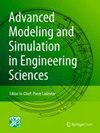Real-world application of a discrete feedback control system for flexible biogas production
IF 3.2
Q3 MECHANICS
Advanced Modeling and Simulation in Engineering Sciences
Pub Date : 2023-11-27
DOI:10.1186/s40323-023-00251-1
引用次数: 0
Abstract
Using renewable energy is increasingly prevalent as part of a global effort to safeguard the environment, with a reduction in $${\mathrm{CO}}_{2}$$ being one of the primary objectives. A biogas plant provides an opportunity to produce green energy, but its profitability prevents it from being utilized more frequently. A suitable response to this economic issue would be flexible biogas production to exploit fluctuating energy prices. Nevertheless, the complex nature of the anaerobic digestion process that proceeds within the biogas plant and the wide range of substrates that may be utilized as the plant’s feeds make it challenging to achieve flexible biogas production truly. Most plant operators will rely on their experience and intuition to run the plant without knowing exactly how much biogas they will produce with the feed substrate. This work combines a system model estimation and feedback controller to provide an intuitive yet precise feedback control system. The system model estimation represents the biogas plant mathematically, and a total of six distinct approaches have been compared and evaluated. A PT1 model most accurately approximated the step-down and the step-up by the time percentage method, with the Akaike Information Criterion as the primary evaluation criterion for selecting the best model. The downward model was controlled by a discrete PI controller modified with the Root Locus Method and an Anti-Windup scheme, and the upward model was controlled by a state space controller. The quality of the controller was evaluated in both simulation and at the actual biogas plant in Grub, and the controller was able to reduce the biogas production rate approaching the setpoint in the expected period. Furthermore, the developed feedback control system is effortless enough to be installed in many biogas plants.离散反馈控制系统在柔性沼气生产中的实际应用
作为全球保护环境努力的一部分,使用可再生能源越来越普遍,减少$${\mathrm{CO}}_{2}$$是主要目标之一。沼气厂提供了生产绿色能源的机会,但其盈利能力使其无法更频繁地利用。对这一经济问题的适当回应是灵活的沼气生产,以利用波动的能源价格。然而,在沼气厂内进行的厌氧消化过程的复杂性,以及可以用作植物饲料的各种底物,使得真正实现灵活的沼气生产具有挑战性。大多数工厂操作员将依靠他们的经验和直觉来运行工厂,而不知道他们将用饲料基质产生多少沼气。这项工作结合了系统模型估计和反馈控制器,提供了一个直观而精确的反馈控制系统。系统模型估计在数学上代表了沼气厂,并对总共六种不同的方法进行了比较和评价。PT1模型以时间百分比法最准确地逼近降压和升压,并以赤池信息准则作为选择最佳模型的主要评价准则。向下模型由根轨迹法改进的离散PI控制器和Anti-Windup方案控制,向上模型由状态空间控制器控制。在模拟和实际沼气厂中对控制器的质量进行了评估,控制器能够在预期时间内将沼气产率降低到接近设定值。此外,所开发的反馈控制系统可以毫不费力地安装在许多沼气厂。
本文章由计算机程序翻译,如有差异,请以英文原文为准。
求助全文
约1分钟内获得全文
求助全文
来源期刊

Advanced Modeling and Simulation in Engineering Sciences
Engineering-Engineering (miscellaneous)
CiteScore
6.80
自引率
0.00%
发文量
22
审稿时长
30 weeks
期刊介绍:
The research topics addressed by Advanced Modeling and Simulation in Engineering Sciences (AMSES) cover the vast domain of the advanced modeling and simulation of materials, processes and structures governed by the laws of mechanics. The emphasis is on advanced and innovative modeling approaches and numerical strategies. The main objective is to describe the actual physics of large mechanical systems with complicated geometries as accurately as possible using complex, highly nonlinear and coupled multiphysics and multiscale models, and then to carry out simulations with these complex models as rapidly as possible. In other words, this research revolves around efficient numerical modeling along with model verification and validation. Therefore, the corresponding papers deal with advanced modeling and simulation, efficient optimization, inverse analysis, data-driven computation and simulation-based control. These challenging issues require multidisciplinary efforts – particularly in modeling, numerical analysis and computer science – which are treated in this journal.
 求助内容:
求助内容: 应助结果提醒方式:
应助结果提醒方式:


